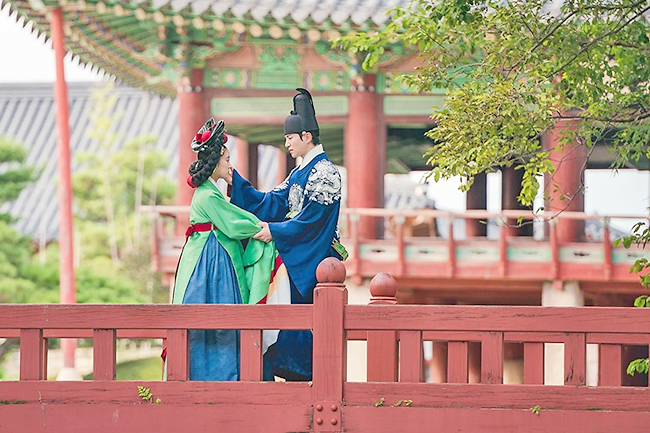ANN/THE KOREA HERALD – South Korea has built a reputation as a drama powerhouse, renowned for its charming romantic comedies and adrenaline-pumping zombie thrillers, exemplified by hits like Crash Landing on You (2019), Kingdom (2019), Hometown Cha-Cha-Cha (2021), and All of Us Are Dead (2019), among others.
However, another beloved genre among viewers is the period drama.
In addition to the gripping narratives often drawn from historical accounts, the captivating settings adorned with hanok, traditional Korean homes, captivate the hearts of many period drama enthusiasts.
Popular tourist spots such as Bukchon Hanok Village in central Seoul or Jeonju Hanok Village in Jeonju, North Jeolla Province, provide a fascinating glimpse into Korea’s architectural legacy. But, some of the iconic spots featured in the 17-part period drama The Red Sleeve beckon travellers with a humble, tranquil and peaceful atmosphere, as seen to be greatly enjoyed by King Jeongjo (Lee Jun-ho) and Seong Deok-im (Lee Se-young), who later becomes the noble consort Uibin Seong.
The series, which aired from November 2021 to January 2022 on terrestrial broadcaster MBC, followed the unlikely romance story and growth of Crown Prince Yi San, who later takes the throne as King Jeongjo.
Though the flowers are yet to bloom, visitors can take a pleasant, light stroll around The Red Sleeve-themed hanok buildings while enjoying the early spring breeze, taking in the new leaves on trees and vibrant colours of hanok buildings, just like King Jeongjo and Deok-im in the beloved historical drama.









GWANGHALLU GARDEN
Gwanghallu Garden, located at the centre of Namwon, North Jeolla Province, is home to stunning architecture and a natural landscape with a lake and trees.
Built by multitalented prime minister Hwang Hui while exiled to Namwon in 1419, the garden expresses the ideals and concepts of the universe held by those in years past.
Gwanghallu Pavilion – the main building of the garden – symbolises the mythical palace on the moon, while the calm, shining waves on the artificial pond show the reflection of the Milky Way. Meanwhile, the three islands in the pond symbolise the homes of legendary hermits and divine entities.
Similar to how Lee Mong-ryong and Chun-hyang – two lovers from the popular pansori, a narrative form singing, entitled Chunhyangga – meet there for the first time, Gwanghallu Pavilion is where Deok-im recognises Crown Prince Yi San for the first time in The Red Sleeve.
The famed bridge Ojakgyo is the most popular photo zone at the garden, allowing families and friends to make memorable photos against a backdrop of Gwanghallu Pavilion. There are, of course, many children who want to simply stare at the water to catch sight of the carp and mandarin ducks swimming in the pond rather than just pose for photos.
Though the garden’s walking trail is covered with dirt, it is soft enough for strollers and wheelchairs. Wooden benches are placed for everyone to relax and soak up the moment in the beautiful garden as well.
Lucky visitors may explore Gwanghallu Garden for free when a TV drama or movie is shooting on site.
“Because the content production company pays the fees, visitors can enter the garden without paying the admission fee.
“The safety guards might ask visitors to stop or take a detour once inside Gwanghallu Garden. But, it will be an exciting experience to watch how such projects are shot as well,” a Gwanghallu Garden official told The Korea Herald.
JEONJU HYANGGYO
Confucian schools, called hyanggyo in Korea, were a type of public education institution familiar during the Goryeo Kingdom (918-1392) and Joseon era (1392-1910).
Jeonju Hyanggyo is located in Wansan-gu, southeastern Jeonju, a city some 250 kilometres south of Seoul. Jeonju Hyanggyo is not only a tourist attraction where the beauty of Korean architecture is on full display, it is also a place where one can get a glimpse of Confucian education.
The ‘seonbi’ -themed programmes are offered for both children and adults throughout the year to explore different facilities at Jeonju Hyanggyo, or participate in activities like a wedding ceremony or archery.
Seonbi refers to the Confucian scholars of Goryeo and Joseon in Korean history. Jeonju Hyanggyo’s main shrine Daeseongjeon was the venue of the festival held for court ladies featured in the third episode of The Red Sleeve.
While the paved stone-covered walking trail to Daeseongjeon affords visitors a clear, wide-open view of Jeonju Hyanggyo, the narrow dirt paths allows visitors to take a light stroll around the old school surrounded by plum blossom trees.
Though some of the once-elegant turquoise and dark brown paint is peeling off, visitors can feel the passage of time as they are surrounded by the sounds of birds chirping and centuries-old buildings that have stood in the same spot all these years. – Lee Si-jin





